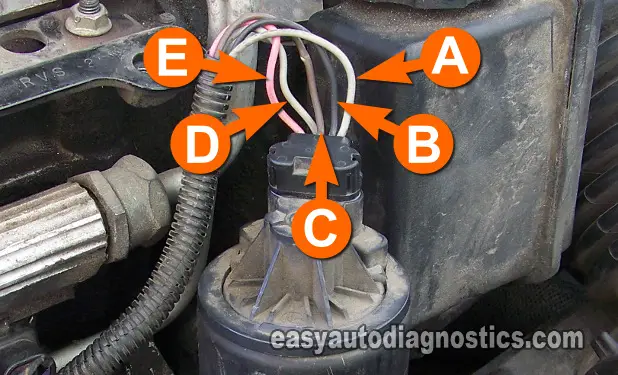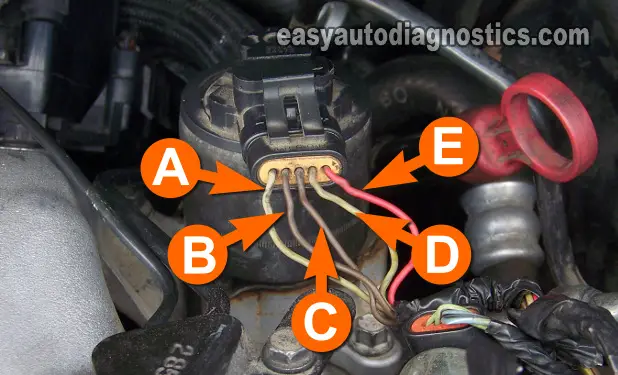TEST 8: EGR Solenoid Resistance
OK, in TEST 2 you verified that the EGR solenoid is getting power (10 to 12 Volts DC). The next step is to measure the resistance of the solenoid itself.
What sucks about this test is not that it's hard to do, but that the EGR valve has to be at room temperature. Why? Well the specs I'm providing for you are with the EGR valve at room temperature, so keep this in mind when doing this test.
Let's get started:
- 1
Place your multimeter in Ohms mode (Ω).
- 2
Disconnect the EGR's electrical connector.
- 3
With the multimeter leads, measure the resistance across the EGR valve pins that connect to wires labeled with the letter A and the letter E.
- 4
If the EGR Solenoid is OK, your multimeter should read 8 to 9 Ohms.
Let's take a look at your test result:
CASE 1: The multimeter registered the indicated Ohms. This result tells you that the EGR solenoid is OK.
So far, you have verified two important things, 1.) The EGR solenoid is getting power and 2.) the solenoid itself passed the resistance test. This leaves two possibilities for the P0403 DTC and they are:
- A problem in the wire labeled with letter A (between the EGR connector and the PCM connector).
- Or the PCM is bad (although this is very rare).
Testing the two above conditions are beyond the scope of this article, but now at least you know what your next steps are.
CASE 2: The multimeter DID NOT register the indicated Ohms. This result tells you that the EGR solenoid is fried. Replacing the EGR valve will solve the EGR DTC P0403.
TEST 9: Useful Notes
OK, you've tested everything and according to the results of your tests, the EGR valve system is OK, so why is the check engine light on with an EGR valve code?... Well, this could have happened because:
- There was a piece (or were pieces of carbon) blocking the EGR valve pintle from seating completely, but probably became dislodged and sucked into the intake manifold. Of course, when the carbon chunks blocked the EGR valve pintle from closing, the check engine light (CEL) came on. By the time you came around to check/test/troubleshoot, these carbon chunks were gone.
It's been my experience that folks that use a Fuel Injector Cleaner are the ones that experience the above condition the most. The fuel injector cleaner not only cleans the fuel injectors, but also the intake Valves and the top of the Pistons of carbon deposits and these may end up blocking the EGR valve.
You may have to wait till all of the gasoline in your gas tank, that's mixed with the fuel injector cleaner, is finished before you see some relief. In the meantime, if the check engine light comes back on with an EGR code and accompanied by a rough idle, you now know you need to remove and clean the EGR valve.
Real Life Case Studies From easyautodiagnostics.com Readers
In this section, is input and feedback from all of the folks who have had an EGR issue with their vehicle and found a solution. If you're one of them, thank you for sharing your experience with all of us! If you want to share your repair and/or diagnostic experience, you can use the contact form below.
Real Life Case Study 1
Vehicle: 2001 Bonneville SSEi 3.8L Supercharged
Trouble Codes: P0401
Complaint: P0401
Test Notes: “I have had the insufficient flow DTC P0401 a few times in the past several years. It almost always comes back to a vacuum leak. It doesn't take much of a vacuum leak to throw the PCM's EGR pressure delta test out of tolerance”
“Keep this in mind when troubleshooting DTC P0401 as any component of the vacuum system can be at fault.”
“The PCM tests the EGR by briefly commanding the EGR full open when you let off the accelerator from 40 to 50 mph. The PCM looks for a sufficient 'loss' of vacuum when the valve is open to verify EGR operation. If you have a vacuum leak, your base vacuum won't allow a large enough delta when the EGR valve opens and the PCM will 'think' there is Insufficient FLow. Hope this helps others.”
Repair: FOUND AND REPAIred VACUUM LEAK.
Info Provided Courtesy of: Greg B.
Real Life Case Study 2
Vehicle: 1999 Chevy, Malibu, 3.1 L VIN "M"
Trouble Codes: P0401
Complaint: 'P0401 insufficient flow, every couple of days to a week after I would reset / cleared it would come back. My wife said it would come back after she would refuel.”
Test Notes: None.
Repair: 'I used a piece of 1/8 inch steel cable about 9-10 inches long since it was more flexible than the coat hanger which was only going in about 4". I chucked it into my variable speed drill this left 8 inches exposed. I inserted into the egr port and turned the drill on at a slow speed. You will know when you have cleared the blockage out because it will go all the way in up to the drill chuck. Final check was to attempt to start the engine. It would not start. I plugged the port started the engine, removed the plug and the engine died. Note here: The port was not quite fully blocked as the engine would start and keep running at a "high idle" and there was engine vacuum at the egr port.”
Info Provided Courtesy of: Stephen J. Nichols
Real Life Case Study 3
Vehicle: 2004 Chevy Impala 3.4
Trouble Codes: P0401 Code at the end of the Drive Cycle.
Complaint: P0401 Code at the end of the Drive Cycle.
Test Notes: 'Drove the car with the multimeter hooked to the Pintle wires and at idle I am at about 0.62 Volts and it will jump up to 2.0 + Volts as I accelerate. I was able to start the engine with the EGR Valve removed and there was no real noticeable ?shutter? or ?stumble? to the engine. I (initially) sprayed B12 Carb Cleaner into the EGR intake port, but this must not have been enough to clear the blockage.”
Repair: ' I pulled off the EGR Valve and ?wallowed? out the EGR tube to the Exhaust Manifold as well as the intake manifold. ”
Info Provided Courtesy of: Rex Young
Real Life Case Study 4
Vehicle: 1994 Chevrolet Blazer 4.3L
Trouble Codes: 'Check Engine Light was on but I don't remember the code.”
Complaint: 'The idle was very rough when I would start it. Idle was rough when I came to a stop.”
Test Notes: 'I had this problem several times before. The e.g.r. valve gets a piece of carbon stuck and stays open all of the time. I just wanted to mention that I tested it by just checking to see if the egr valve was hot after starting the engine cold. It works, the egr valve has to be cool to the touch with the engine just having started. If the egr is hot right after starting the cold engine, then i know the egr has a piece of carbon stuck in it. works every time.”
Repair: ' I took the egr valve off and removed the piece of carbon that was stuck in it. problem solved, it idles great. ”
Info Provided Courtesy of: T. Thomas

If this info saved the day, buy me a beer!



